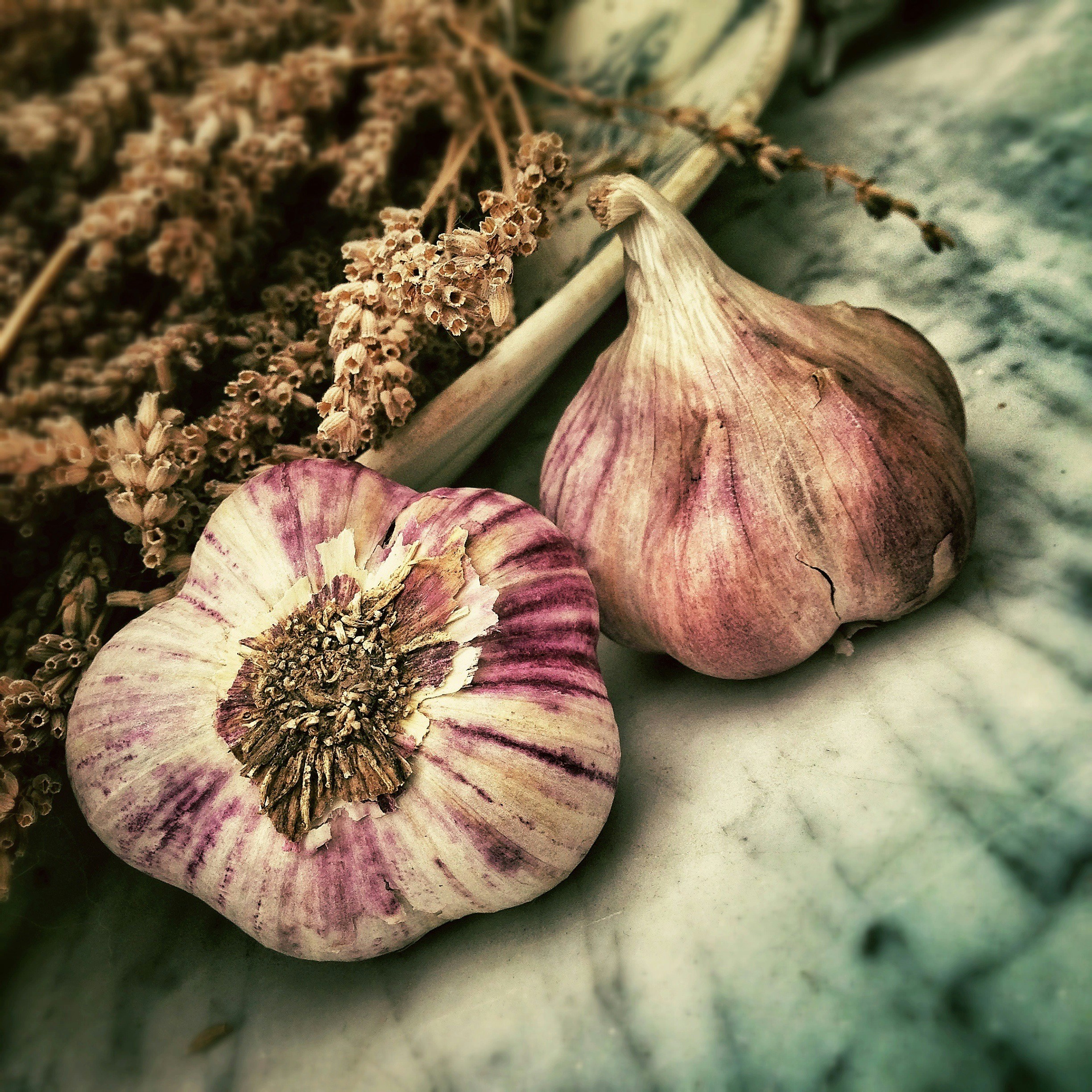10 Practical Benefits And Uses Of Garlic For Health

- What Is Garlic? Where Does It Come From?
- Raw Garlic vs. Cooked Garlic Benefits
- Allicin In Garlic Explained
- Top 10 Benefits and Uses for Garlic
- 1. Garlic For Illness And Colds Explained
- 2. Garlic For Repelling Mosquitoes Explained
- 3. Garlic For Blood And Blood Pressure Explained
- 4. Garlic For Weight Loss Explained
- 5. Garlic For Mental Illness, Alzheimer's, Dementia Explained
- 6. Garlic For Cough and Cold Explained
- 7. Garlic For Detoxing And Bone Health Explained
- 8. Garlic For Skin And Hair Explained
- 10. Garlic For Diabetes Explained
- Side Effects Of Eating Too Much Garlic
- Bad Breath and Body Odor
- Heartburn, Nausea, and Other Effects of Eating Too Much Garlic
- Conclusion
“You have to hear this story!” my aunt exclaimed when I met her recently. My aunt has a ten-year-old granddaughter who has suffered from insomnia for as long as she can remember. Nothing seemed to work. No matter how sleep-deprived her granddaughter felt, she would lie awake for hours every single night. One night, my aunt decided to try a natural remedy she had heard about to help her granddaughter fall asleep. At the very least, it couldn’t hurt. While her granddaughter was showering, my aunt slipped a few cloves of garlic under her pillow in a small bag. A little while later, my aunt and her granddaughter were chatting on the guest bed where her granddaughter was to sleep. Suddenly, her granddaughter says, “Grandma, I’m tired. I want to go sleep.” My aunt claims she has never in her life uttered these words – and certainly not at 8:30 pm.
Within minutes of her head touching her pillow, she was fast asleep.“Maybe it was a one-time occurrence?”
My aunt informed her daughter about what happened. Her daughter began to do the same at home and noticed similar results. Her granddaughter’s sleeping issues have improved tremendously, and she no longer lies awake until the wee hours of the morning.
After I heard this story I became intrigued and began to wonder about other possible qualities of garlic. I surprisingly learned that it has so many benefits for mental and physical health.
Do you love the taste it gives to your food? It’s actually doing a lot more than pleasing your taste buds. Read on to find out the health benefits of breaking into that garlic bulb and how incorporating this superfood into your diet can help with many aspects of your overall health.
What Is Garlic? Where Does It Come From?

What is garlic?
Garlic, or Allium Sativum, as it is known scientifically, is part of the lily, or Liliaceae family and is related to the onion, leek, chive, shallot and Chinese onion. It is famous for its strong flavor and smell, and as such, is added to seasoning rather than eaten on its own.
The vegetable has an ancient history and is even referenced to in the Bible and found in ancient Egyptian tombs. In ancient and medieval societies garlic was known for its healing properties, to increase physical strength and as repellents for believed evil.
Although this herb is native to Central Asia, it can be found in many parts of the world. Garlic generally grows to be approximately 2 feet tall, and grow leaves from the stem of the bulb.
Depending on the time period in history, garlic consumption has either been despised or revered. Often, such as in Ancient Egypt, its powerful properties were realized and respected, but it was still not considered an acceptable food to be eaten by people of the upper or aristocratic class. Nowadays people love eating garlic in all shapes and forms, such as garlic powder, minced garlic, roasted in olive oil or fresh cloves.
Raw Garlic vs. Cooked Garlic: Is There A Difference In Benefits To Eating Either?
Unfortunately, cooking garlic decreases its health benefits. It’s known for its anti-inflammatory quality. It’s also widely regarded as being good at combating cardiovascular diseases because it contains the compound allicin.
When you crush garlic, you cause it to react with another compound and form allicin.
The benefits against heart disease found in garlic are attributed to the activity of the formed allicin. However, cooking it straight away causes alliinase to be inactive.
In order to get the maximum health benefits from garlic, you should crush it, and then leave it for at least 10 minutes before cooking it, allowing the alliinase to take effect. It’s best to cook it for as short amount of time as possible, to keep its health properties active.
Allicin In Garlic Explained
As you can see from the above paragraph, allicin is accountable for garlic’s superpowers. Allicin has anti-fungal, anti-viral, anti-oxidative and antibacterial properties.
Described as “unstable” due to the fact that it reacts to the enzymes in contact with it and then changes, allicin is responsible for many of the positive effects of garlic.
Unfortunately, allicin can be short lived while the plant is growing. When there is a threat from an insect or pest to garlic, allicin forms to fight the threat. The allicin produced dies fairly quickly; however, the garlic still has properties that can activate allicin against future dangers to the plant. You can also activate the properties by crushing a clove.
The garlic plant uses what it needs to keep away threats, but also saves some of this amazing compound for the future, which works for us!
We all recognize the smell of garlic, but what you may not know is that allicin is what is responsible for giving garlic its odor.
It’s also an incredible anti-bacterial agent because it behaves totally different to other antibiotic substances. It’s about 1000 times harder for bacteria to become resistant to allicin than to build up resistance to certain other antibiotics.
Ever noticed that while your peppers, tomatoes and other vegetables go bad after a short amount of time, garlic seems to last for ages? That’s because the allicin fights off fungal properties – like the stuff found in mold.
Garlic extracts have anti-fungal properties. If you suffer from athlete’s foot, rubbing a warm clove of roasted garlic can help relieve symptoms. It can also help with other ailments, like ear infections, acne and to prevent small wounds from becoming infected. It is crazy the amount of health benefits found from allicin!
Top 10 Benefits and Uses for Garlic
1. Garlic For Illness And Colds Explained

Garlic For Colds.
Although the proofs for garlic working to fight colds haven’t been as formally proven as its other health benefits, it is nonetheless accepted as a good cure for the common cold, which reduces symptoms or can even help you completely avoid catching one.
This is believed to be because of the allicin, which fights off bacteria. Raw garlic is supposed to be a great anti-decongestant. If you feel a cold or flu coming on, eating a clove (either crushed or, as gross as it sounds, just chewing the clove plain) every few hours should get rid of the sickness pretty quickly.
If you have a sore throat, try sucking on a slice of raw garlic for 15 minutes to alleviate the pain.
Alternatively, if you can’t face the thought of eating raw garlic on its own, you could mince the garlic and wait for the allicin to be activated, and then either mix it with orange or lemon juice or eat it on bread with honey.
2. Garlic For Repelling Mosquitoes Explained

Enjoy being mosquito-bite free with the help of garlic.
Tired of being told that you get so many mosquito bites because “you’re too sweet”? Go from sweet to savory by using garlic as a mosquito repellent!
Eating garlic can give you a slight level of protection against mosquito bites because mosquitos will be turned off by the smell of your breath (your date might be too, so do so carefully!). But an added benefit of eating garlic is that it causes you to release sulfur compounds through your skin, and these repel the mosquitos as well.
Using garlic spray in places such as your garden can also help keep mosquitos at bay and away. Some researchers also found that garlic oil can kill mosquito larvae on plants, which means that you won’t have new mosquitos coming to greet you. If you really want to make an effort to ward off mosquitos, you can make a blend of one percent garlic oil, beeswax and petroleum jelly and then rub it into your arms and legs. This should give you protection from bites for about eight hours.
3. Garlic For Blood And Blood Pressure Explained

Garlic can help with blood pressure and cholesterol.
Allicin also helps to lower blood pressure levels. Fascinatingly, in a study done involving people taking garlic supplements, people with regular and high blood pressure were observed. Those who had high blood pressure levels found that their blood pressure went down, whereas those with normal blood pressure saw no change.
High blood pressure is one of the main causes of heart attacks and stroke, but the good news is that research has found that the allicin in garlic can significantly lower blood pressure levels.
Allicin relaxes the mesenteric arteries (channels in your body that carry blood to your digestive tract), which thins the blood and prevents clotting – one of the things that cause a heart attack or stroke. In addition, high blood pressure increases the risk of high cholesterol and vice versa.
Garlic comes to the rescue here, as well, by stopping the body from turning fat into cholesterol, thereby lowering your blood pressure, and in effect, your chances of suffering a heart attack.
An intake of a half or whole clove a day can lower your cholesterol levels by 9 to 12 percent (while still increasing positive levels of cholesterol known as HDL cholesterol) which can make a marked difference to your health over an extended period.
Additionally, red blood cells process some of the nutrients in garlic. This helps blood vessels in the body relax, consequently increasing blood flow. Through this, consuming garlic gives you a lower risk of heart disease.
Learn about Clove Essential Oil here at Maple Holistics!
4. Garlic For Weight Loss Explained

Add garlic to your diet for even healthier eating.
It turns out that adding garlic to your food can actually help you trim your waistline. As if you needed another reason to love garlic! But why is this so?
Well, garlic can boost a person’s energy, which means that they’ll be better equipped to burn calories. And it can also speed up a person’s metabolism, which will also help the body lose more weight.
Another benefit is that it can help suppress your appetite so that you’re tempted to eat fewer calories during the day. You’ll be satisfied by what you eat for a longer period of time, so by minimizing your need for more calories you won’t find yourself putting on weight.
But what if you still decide to eat more than you need, despite garlic’s appetite-suppressing ways? Lucky for you, researchers found that garlic can stimulate the burning of fat in your body, so garlic’s got your back.
And one last amazing aspect of garlic is that it’s a wonderful detoxifying agent. What exactly does this mean? Essentially, it means that it can assist your body in flushing out toxins that may interfere with your digestive system. So eating garlic will make sure that the food you eat gets digested properly and efficiently.
5. Garlic For Mental Illness, Alzheimer’s, Dementia Explained

Eating garlic can help keep your mind sharp as you age.
Garlic is also believed to be a great aid for mental illnesses and also the likes of dementia and Alzheimer’s disease. High cholesterol levels and high blood pressure levels increase the chance of developing dementia later on in life.
Since it helps lower blood pressure and prevent cholesterol levels from escalating, it in effect also decreases the risk of developing dementia or other mental illnesses.
Recently, there have been studies surrounding a component found in aged garlic extract (AGE) known as FruArg and its effects on mental illnesses. Your body has an incredible immune system, which allows it to keep the good in your body and get rid of the bad.
Part of your immune system’s job is for Microglia cells to dispose of dead neuron cells. This makes room for new, healthy cells to grow. In an average, healthy person, this is a wonderful and healthy phenomenon.
But if a person is living an unhealthy lifestyle – consuming a lot of alcohol, excessive smoking – or has suffered from brain damage, the immune system goes above and beyond what it needs to do, and starts attacking the brain’s healthy cells.
This happens when the body senses stress or inflammation (caused by the above triggers or even simply ageing). Your body responds by forming extra microglia cells, which automatically produces nitric oxide.
An abundance of nitric oxide leads to inflammation in the brain and neuronal damage. A study showed that FruArg produced more antioxidants, which healed these damaged cells and protected other healthy cells from the attack of nitric oxide. It also caused the microglia cells to “calm down” and produce less nitric oxide – effectively decreasing the risk of developing mental illness.
5 surprising health benefits of #garlic https://t.co/ROT4BGGpAY via @Fact_Factories
— Vitamin Patch Club (@vitaminpatchclb) November 5, 2017
6. Garlic For Cough and Cold Explained
Garlic is good for helping alleviate coughs for both young and old. Its healing properties have made it a tool in treating whooping cough in kids, but it’s good for adults too! It will help boost your immune system, thin mucous to relieve your throat discomfort and coughing symptoms, and act as an expectorant.
Garlic can also help ward off colds or shorten them, which can prevent coughs and a whole host of other symptoms. This amazing quality is due to many of garlic’s properties. It’s a strong antioxidant (thanks to ajoene) which contains both antiviral and antibiotic elements. It also acts as a decongestant- so if you do get sick, your symptoms will be more mild.
And we all know about the importance of Vitamin C in preventing and fighting the common cold. Since garlic has Vitamin C, alongside minerals like selenium and sulphur, it’s a great way to protect yourself in the cold winter months.
The allicin in garlic is a big part of its healing quality. But since it’s only present for a short time after you crush fresh garlic, eating it fresh is a great way to keep yourself healthy.
7. Garlic For Detoxing And Bone Health Explained

Garlic can make your bones strong by helping your body absorb calcium.
But garlic’s astonishing health benefits don’t end there. It aids the body in detoxing (getting rid of all the toxins in your body) by promoting glutathione production. Glutathione is an antioxidant that removes toxins from your digestive system. Garlic also improves bone health.
While eating garlic won’t do the job of your liver and kidneys, it does have a whole lot of nutrients like vitamin C, which are good for detoxing your liver.
Besides containing other enzymes and antioxidants that help your body absorb calcium (and reduce oxidative stress), garlic also contains manganese, zinc, and vitamin B6, as well as a compound called diallyl disulphide, all of which do wonders for your bones and contribute to your health.
Many middle-aged women suffer from osteoporosis (weakened bones) and other bone disorders. Garlic can help with these conditions by elevating estrogen levels, which in turn reduces the risk of bone loss.
8. Garlic For Skin And Hair Explained
The health benefits of garlic extend to your skin and hair as well. The use of garlic improves hair loss, strengthens hair, nourishes skin, and alleviates blemishes on from blackheads, pimples, eczema and psoriasis.
Blackheads and pimples are the results of your sebaceous glands releasing excessive amounts of oil. Garlic contains compounds called polyphenols, which control the extra secretion, thus assuaging the symptoms of acne.
Garlic seems to have endless benefits for hair health. To encourage hair growth or to strengthen your hair, try mixing one tablespoon of garlic juice (juice from about 8 cloves) to one tablespoon of honey and massage it into your scalp twice a day. Leave it in for approximately an hour and then rinse it out. You should notice a positive difference in your hair. How does this work?
The abundance of Vitamin C in raw garlic boosts collagen production, which helps your hair grow strong and healthy, and its anti-microbial properties get rid of any germs that are stopping your hair from growing.
Because of its anti-fungal properties, garlic is also a good way to cure dandruff.
Garlic contains minerals vital for hair growth, such as calcium, sulphur and zinc. And allicin plays a role here, too; allicin helps with blood circulation, which is linked to improved hair growth.
10. Garlic For Diabetes Explained
Garlic is a nifty little tool when it comes to managing type 2 diabetes. Studies indicate that eating one clove or more a day can help regulate your blood sugar levels and also improve your body’s insulin sensitivity.
For those suffering from diabetes who ate garlic regularly, their fasting blood glucose was much lower after just a couple of weeks. Also, a person’s A1C (their average blood sugar level for the previous 2-3 months) was noticeably lower after 12 weeks.
So how does this herb work its magic in this way? It’s all thanks to allicin, allyl propyl disulfide and S-allyl cysteine sulfoxide. These all raise a person’s insulin levels in their blood by inhibiting the liver’s inactivation of insulin, consequently making the insulin more available for the body to use.
As an added bonus, garlic consumption can also help stop or minimize the effects of some of the complications of diabetes. For instance, high blood pressure tends to occur in patients with type 2 diabetes, and garlic is known to be helpful in combating this issue.
Side Effects Of Eating Too Much Garlic
Bad Breath and Body Odor

Too much garlic can give you bad breath.
As with everything in life, there can still be too much of a good thing. Eating too much garlic (for most healthy people, this is upwards of four cloves every day) can be harmful, and can cause various side effects, from unpleasant to downright dangerous.
Bad breath and body odor – this is a no-brainer.
While the allicin in garlic is great for our health, it also gives it its strong and powerful smell. This smell will linger in the mouth and even in the body, if consumed in unhealthy amounts.
Too much can make the sweat smell, making it seem like you are sweating excessively.
Heartburn, Nausea, and Other Effects of Eating Too Much Garlic
- Heartburn; Acidity in garlic can cause burning sensations, including heartburn.
- Nausea; Nausea and vomiting occurs particularly when over-consuming garlic on an empty stomach.
- Diarrhea; When taken in disproportionate amounts, garlic’s laxative effects can go too far, resulting in diarrhea.
- Low blood pressure; When used in conjunction with blood pressure medication, garlic can leave your blood pressure too low. Be sure to ask your doctor about safe consumption if you are taking medication against HBP. A side effect of low blood pressure is dizziness.
- Burning in the stomach/ gastrointestinal issues; Burning sensations can be caused by your stomach acids reacting to the strong compounds found in garlic. This is especially true when eaten on an empty stomach.
- Garlic in pregnancy; Because of its strength, pregnant and nursing women should speak to their doctor about safe garlic consumption. It can induce labour, which can be unsafe.
- Blood-thinning/ Bleeding; Garlic thins your blood, which clears your arteries and improves you heart health. This can become dangerous if you are already taking blood-thinning medication. Garlic can prevent your blood from clotting and healing injuries. It’s also best to stop eating garlic two weeks before surgery. If you don’t, it can lengthen the time for a wound to heal.
- Hyphema; This condition, which can cause permanent blindness, is bleeding in the eye chamber between the iris and cornea. Hyphema can be exacerbated by over consuming garlic, so caution must be taken.
- Other symptoms of eating too much garlic include allergic reaction (characterized by difficulty breathing), inflammation, skin irritation, headaches, and loss of appetite.
So, while garlic has lots of positives attributes, be sure to stay within the parameters of healthy consumption. It does wonders for your body, but like everything, moderation is definitely in order.
Conclusion
Before I started researching for this article, I hadn’t given much thought to the amount of garlic in my meals. I regularly add it to bread, marinades, dressings, and seasonings.
Despite using it all the time, for some reason, I never gave its health benefits any thought.I’ve concentrated on leafy greens, nuts, fruits and grains, but have honestly never given a second thought to garlic. As such, I was amazed to discover all of garlic’s health benefits.
Although care must be taken not to eat too much of it, the benefits of garlic are undeniable. If you’re looking for a simple way to improve your health, try adding a clove to your dishes. Not only will they taste better, but your body will thank you for it, too.



